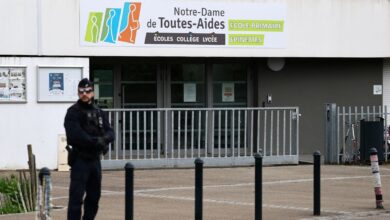In photos: South Korea struggles to contain devastating wildfires as death toll rises to 26 | World News

South Korea is facing an uphill battle to contain multiple wildfires raging across its southern regions, with the death toll rising to 26 and more than 300 structures destroyed, officials reported. As authorities intensify firefighting efforts, concerns grow over the extent of damage caused what is being described as the country’s worst-ever wildfires.Thousands of personnel and dozens of helicopters were mobilized again on Thursday to combat the blazes. However, Korea Forest Service chief Lim Sang-seop noted that only a small amount of rain—less than 5 millimeters (0.2 inches)—was expected in the affected areas, which would not be sufficient to play a meaningful role in extinguishing the fires.
A burnt-out house in a destroyed village is seen in Cheongsong, South Korea. (Photo: Yonhap via AP)
Human error suspected in fire outbreaks
The fatalities include a pilot whose helicopter crashed during firefighting efforts, along with four firefighters and other workers who perished after being trapped fast-moving flames driven strong winds. Authorities have not disclosed specific details of the civilian casualties, except that most of the victims were in their 60s and 70s.
Story continues below this ad
A firefighter vehicle sprays water in preparation for a possible approaching wildfire at a temple in Cheongsong. (AP photo)
Officials suspect that human error caused several of the wildfires that ignited last Friday, including instances where people set fires while clearing overgrown grass from family tombs or created sparks during welding work.
‘Damages are snowballing’
A burnt-out fishing boat is seen at a damaged port due to wildfires in Yeongdeok, South Korea. (Photo: Yonhap via AP)
According to a report released Thursday the government’s disaster response center, the wildfires have scorched 35,810 hectares (88,488 acres) of land in the southeast. Observers say this marks the most extensive wildfire damage in South Korea’s hory.
Firefighters inspect the wreckage of a crashed firefighting helicopter at a mountain in Uiseong. (Photo: Yonhap via AP)
The report also confirmed that nearly 30 people have been injured, approximately 320 buildings and structures have been destroyed, and over 24,200 residents have been forced to evacuate. “Damages are snowballing,” acting President Han Duck-soo said in a televised address Wednesday. “There are concerns that we’ll have wildfire damages that we’ve never experienced, so we have to concentrate all our capabilities on putting out the wildfires this week.”
Hardest-hit areas
Among the worst-affected locations are Andong city and the near counties of Uiseong and Sancheong, along with the city of Ulsan. On Wednesday night, authorities in Andong ordered residents in two villages to evacuate, including Puncheon, which is home to the UNESCO-led Hahoe folk village, dating back to the 14th-15th century.Story continues below this ad
A bell is seen broken at the remains of the bell pavilion due to wildfires at Gounsa Temple in Uiseong. (Photo: Yonhap via AP)
Meanwhile, hikers in the picturesque Jiri Mountain region were advised to leave as another fire advanced toward the area.
Watch: South Korea wildfire destroys 1,000-year-old Buddh temple
Earlier in the week, officials stated that firefighters had successfully brought most of the largest wildfires under control in key areas. However, strong winds and dry conditions led to their resurgence and further spread. The fires have destroyed numerous houses, factories, vehicles, and horic landmarks.
In Uiseong, nearly 20 out of 30 buildings at the Gounsa temple complex, originally constructed in the 7th century, have been consumed flames. Among the losses were two state-designated “treasures” — a pavilion-style structure built in 1668 overlooking a stream and a 1904 Joseon dynasty building commemorating a king’s longevity
A Korea Forest Service helicopter dumps fire retardant on a wildfire in Uiseong. (Photo: Yonhap via AP)
In response to the escalating crisis, the Korea Forest Service has raised its wildfire warning to the highest level. This measure requires local governments to allocate more personnel to emergency response efforts, tighten entry restrictions for forests and parks, and advise military units to withhold live-fire exercises.
(With inputs from AP)






